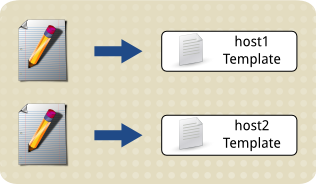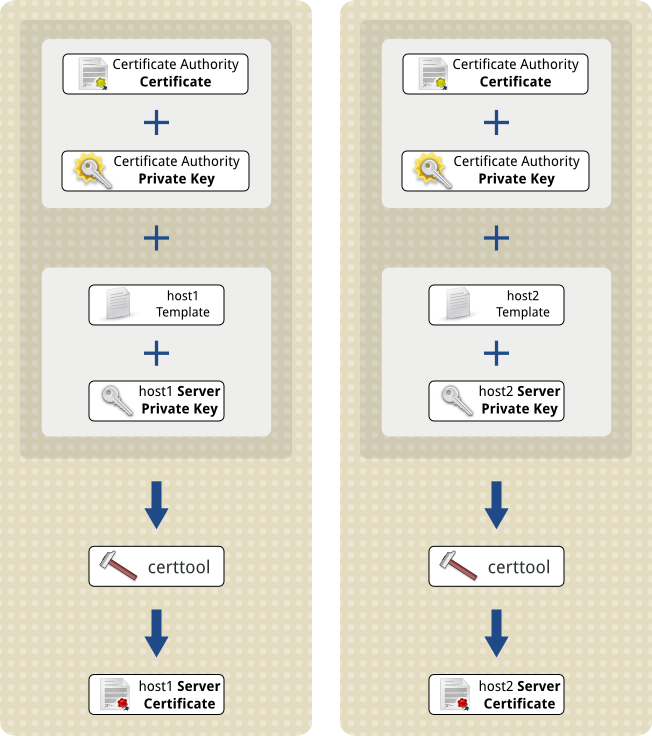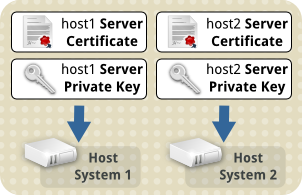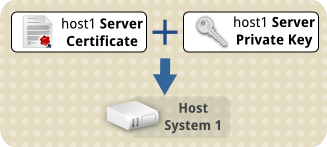Creating Transport Layer Security Server Certificates for libvirt¶
In our example scenario we have two Virtualisation Servers being set up for TLS communication. We also have the Certificate Authority Certificate and its private key created in the previous step.

In this step we create the TLS Server Certificates our hosts need, then move them into place on the hosts.
When these Server Certificates are in place, and with libvirt properly configured, TLS clients will be able to communicate with them.
Create the Server Certificates¶
This can be done wherever you have both the Certificate Authority Certificate file, and its private key.
We use the utility certtool, from the gnutls-utils package for many parts of this.



Create the Server Certificate Template files using a text editor¶

These are plain text files, one for each virtualisation host server, containing the following fields:
organization = Name of your organization cn = Host Name tls_www_server encryption_key signing_key
The Name of your organization field should be adjusted to suit your organization, and the Host Name field must be changed to match the host name of the virtualisation host the template is for.
For our example scenario, this gives:
# cat host1_server_template.info organization = libvirt.org cn = host1 tls_www_server encryption_key signing_key
# cat host2_server_template.info organization = libvirt.org cn = host2 tls_www_server encryption_key signing_key
# ls -al *server_template.info -rw-r--r--. 1 root root 82 Aug 25 13:26 host1_server_template.info -rw-r--r--. 1 root root 82 Aug 25 13:26 host2_server_template.info
Create the Server Certificate Private Key files using certtool¶
Generate the private key files, to be used with the Server Certificates.

These keys are used to create the TLS Server Certificates, and by each virtualisation host when the virtualisation system starts up.
We create a unique private key per virtualisation host, also ensuring the permissions only allow very restricted access to these files:
# (umask 277 && certtool --generate-privkey > host1_server_key.pem) Generating a 2048 bit RSA private key...
# (umask 277 && certtool --generate-privkey > host2_server_key.pem) Generating a 2048 bit RSA private key...
# ls -al *_server_key.pem -r--------. 1 root root 1675 Aug 25 13:33 host1_server_key.pem -r--------. 1 root root 1675 Aug 25 13:33 host2_server_key.pem
NOTE - The security of these private key files is very important.
If an unauthorised person obtains a server private key file, they could use it with a Server Certificate to impersonate one of your virtualisation hosts. Use good unix security to restrict access to the key files appropriately.
Combine the template files with the private key files, to create the Server Certificate files¶

We generate the Server Certificates using the template files, along with the corresponding private key files. Also, the Certificate Authority Certificate file is added along with its private key, to ensure each new server certificate is signed properly.
For our two virtualisation hosts, this means:
# certtool --generate-certificate \
--template host1_server_template.info \
--load-privkey host1_server_key.pem \
--load-ca-certificate certificate_authority_certificate.pem \
--load-ca-privkey certificate_authority_key.pem \
--outfile host1_server_certificate.pem
Generating a signed certificate...
X.509 Certificate Information:
Version: 3
Serial Number (hex): 4c749699
Validity:
Not Before: Wed Aug 25 04:05:45 UTC 2010
Not After: Thu Aug 25 04:05:45 UTC 2011
Subject: O=libvirt.org,CN=host1
Subject Public Key Algorithm: RSA
Modulus (bits 2048):
da:75:bd:37:ac:30:4a:6c:fe:8c:8b:d9:d8:f4:94:80
5e:48:68:31:e7:de:85:d3:d7:54:13:da:8d:d1:f1:21
3b:d9:f1:eb:86:0a:4e:59:39:2c:53:ee:3e:81:29:7d
e5:83:6b:bd:e9:86:93:7c:ce:a4:5b:37:b3:b6:6d:7a
7e:60:14:99:4a:23:18:e3:0f:ff:58:68:09:08:f3:0f
ca:76:0d:bc:76:e0:8b:38:93:42:f6:8f:b9:d6:4c:21
2a:0e:d9:cd:1c:33:04:36:a3:eb:97:6b:84:bc:88:16
8e:0b:80:46:ed:ce:c5:56:fe:3b:f7:32:a7:91:c3:1f
86:b7:49:77:7b:35:e7:f4:a6:7a:3c:c9:0d:60:fd:b2
b7:e7:d9:02:02:a5:ef:e9:0c:43:14:15:3b:ef:96:52
a6:f9:ca:d5:fc:c0:fb:a0:5a:1f:69:6f:ce:66:0c:fc
d5:42:86:85:7e:ab:24:15:3e:5b:a3:85:a1:3b:41:ec
11:7c:6c:3d:14:8b:a5:14:7a:7b:79:15:a0:f6:79:2f
30:a9:a1:6e:8c:5e:3a:97:af:8e:7c:c0:a4:1f:2a:32
8b:4f:6b:53:e4:f0:28:48:db:2b:4c:0d:94:95:56:f0
53:e8:0f:ad:1a:a5:cf:35:e4:e3:0c:a6:ba:85:8a:33
Exponent (bits 24):
01:00:01
Extensions:
Basic Constraints (critical):
Certificate Authority (CA): FALSE
Key Purpose (not critical):
TLS WWW Server.
Key Usage (critical):
Digital signature.
Key encipherment.
Subject Key Identifier (not critical):
6ddcfcc00a5ffe064a756d2623ea90fa20ff782c
Authority Key Identifier (not critical):
9512006c97dbdedbb3232a22cfea6b1341d72d76
Other Information:
Public Key Id:
6ddcfcc00a5ffe064a756d2623ea90fa20ff782c
Signing certificate...
This will have created the TLS Server Certificate file, host1_server_certificate.pem, for host1:
# ls -la host1_server_certificate.pem -rw-r--r--. 1 root root 1164 Aug 25 14:05 host1_server_certificate.pem
We do the same thing for host2, after adjusting the input and output files names:
# certtool --generate-certificate \
--template host2_server_template.info \
--load-privkey host2_server_key.pem \
--load-ca-certificate certificate_authority_certificate.pem \
--load-ca-privkey certificate_authority_key.pem \
--outfile host2_server_certificate.pem
Generating a signed certificate...
X.509 Certificate Information:
Version: 3
Serial Number (hex): 4c7496d0
Validity:
Not Before: Wed Aug 25 04:06:40 UTC 2010
Not After: Thu Aug 25 04:06:40 UTC 2011
Subject: O=libvirt.org,CN=host2
Subject Public Key Algorithm: RSA
Modulus (bits 2048):
d3:5d:8f:b6:6f:12:22:ac:4a:e8:d8:37:f6:f7:63:3d
47:26:c6:0d:10:be:ad:12:52:22:26:9f:2f:12:29:57
b8:bf:2b:97:70:88:1d:12:e5:df:05:65:8b:ee:a6:18
30:60:2d:70:bc:dd:99:bf:61:42:9e:55:9c:a1:a7:75
b1:02:68:52:22:57:e0:d6:e4:8b:4b:26:77:56:36:b8
9f:b8:fe:d8:cd:af:04:c2:17:76:9c:f3:48:19:45:63
b5:8d:21:a3:8e:3d:d5:5b:63:9e:3e:e9:86:51:2a:ad
18:27:a1:e5:09:73:7a:c5:34:14:8a:d7:c6:c6:a2:d8
91:96:36:c3:87:3e:45:56:a5:bb:77:d4:10:04:d0:68
68:f8:60:e2:d4:4f:c6:27:cf:e5:e9:47:79:11:c3:95
6d:53:f2:dd:43:c1:ec:80:ac:ac:0c:d9:3d:94:54:41
60:03:01:07:b2:e8:c7:4c:6b:52:c1:38:d1:6d:0a:70
86:e9:be:64:21:73:b8:51:a3:2e:01:9b:7e:fd:9d:37
5c:ad:47:8e:c3:bc:1f:a2:35:bb:84:f3:98:d3:9c:c2
9a:57:1c:c2:be:84:fe:3e:d1:af:25:21:6e:67:60:bb
e3:29:0f:d0:70:d7:b0:f7:8e:ed:7d:e1:b3:ad:1d:3b
Exponent (bits 24):
01:00:01
Extensions:
Basic Constraints (critical):
Certificate Authority (CA): FALSE
Key Purpose (not critical):
TLS WWW Server.
Key Usage (critical):
Digital signature.
Key encipherment.
Subject Key Identifier (not critical):
3df1e4ef69e23976a829700f28f5cbb1685364d9
Authority Key Identifier (not critical):
9512006c97dbdedbb3232a22cfea6b1341d72d76
Other Information:
Public Key Id:
3df1e4ef69e23976a829700f28f5cbb1685364d9
Signing certificate...
This will have created the TLS Server Certificate file, host2_server_certificate.pem, for host2:
# ls -la *server_certificate.pem -rw-r--r--. 1 root root 1164 Aug 25 14:05 host1_server_certificate.pem -rw-r--r--. 1 root root 1164 Aug 25 14:06 host2_server_certificate.pem
The template files are no longer needed, so can be discarded¶

# rm host1_server_template.info host2_server_template.info
Moving the Certificates into place¶
Now the Server Certificates have been created, it is time to move them into place on the hosts.

The default location the libvirt daemon looks for the Server Certificate file is /etc/pki/libvirt/servercert.pem. The private key to match this needs to be in /etc/pki/libvirt/private/serverkey.pem. You will likely have to create the directories to hold these files.
The private key file should be kept secure, with only the root user able to access it in any way. The server certificate file is not as sensitive.
Ownership, Permissions, and SELinux labels¶
Reasonable ownership and permissions for these two files, and the directories containing them, are:
Directory: /etc/pki/libvirt/ Ownership: root:qemu Permissions: u=rwx,g=rx,o=rx (755) SELinux label: system_u:object_r:cert_t:s0
Server Certificate path: /etc/pki/libvirt/servercert.pem Ownership: root:qemu Permissions: u=r,g=r,o= (440) SELinux label: system_u:object_r:cert_t:s0
Directory: /etc/pki/libvirt/private/ Ownership: root:qemu Permissions: u=rwx,g=rx,o= (750) SELinux label: system_u:object_r:cert_t:s0
Private Key for Server Certificate: /etc/pki/libvirt/private/serverkey.pem Ownership: root:qemu Permissions: u=r,g=r,o= (440) SELinux label: system_u:object_r:cert_t:s0
The SELinux labels are only relevant if your servers have SELinux enabled. They can be ignored if SELinux is disabled.
Also take into account your site security practices and requirements, as they may require things to be done differently.
Transferring the files and setting them up¶
In the example below, we use the utility scp to transfer the certificate and key to each host. We then log in directly to each host to move the files into place and set their permissions accordingly.
Transferring the files to host1¶

Notice the filenames are being changed in the transfer
# scp -p host1_server_certificate.pem someuser@host1:servercert.pem someuser@host1's password: host1_server_certificate.pem 100% 1164 1.1KB/s 00:00
# scp -p host1_server_key.pem someuser@host1:serverkey.pem someuser@host1's password: host1_server_key.pem 100% 1675 1.6KB/s 00:00
Logged into host1¶
First we create the directories and set their permissions:
# mkdir -p /etc/pki/libvirt/private
# chmod 755 /etc/pki/libvirt
# chmod 750 /etc/pki/libvirt/private
Then we move the files into place and set their permissions:
# mv servercert.pem /etc/pki/libvirt
# mv serverkey.pem /etc/pki/libvirt/private
# chgrp qemu /etc/pki/libvirt \
/etc/pki/libvirt/servercert.pem \
/etc/pki/libvirt/private \
/etc/pki/libvirt/private/serverkey.pem
# chmod 440 /etc/pki/libvirt/servercert.pem \
/etc/pki/libvirt/private/serverkey.pem
If the server has SELinux enabled, we also update the SELinux labels:
# restorecon -R /etc/pki/libvirt \
/etc/pki/libvirt/private
$ ls -laZ /etc/pki/libvirt /etc/pki/libvirt: total 20 drwxr-xr-x 3 root qemu system_u:object_r:cert_t:s0 . drwxr-xr-x. 8 root root system_u:object_r:cert_t:s0 .. drwxr-x--- 2 root qemu system_u:object_r:cert_t:s0 private -r--r-----. 1 root qemu system_u:object_r:cert_t:s0 servercert.pem
$ ls -laZ /etc/pki/libvirt/private/ /etc/pki/libvirt/private/: total 16 drwxr-x--- 2 root qemu system_u:object_r:cert_t:s0 drwxr-xr-x 3 root qemu system_u:object_r:cert_t:s0 .. -r--r-----. 1 root qemu system_u:object_r:cert_t:s0 serverkey.pem
Transferring the files to host2¶

Notice the filenames are being changed in the transfer
# scp -p host2_server_certificate.pem someuser@host2:servercert.pem someuser@host2's password: host2_server_certificate.pem 100% 1164 1.2KB/s 00:00
# scp -p host2_server_key.pem someuser@host2:serverkey.pem someuser@host2's password: host2_server_key.pem 100% 1675 1.8KB/s 00:00
Logged into host2¶
First we create the directories and set their permissions:
$ sudo mkdir -p /etc/pki/libvirt/private
$ sudo chmod 755 /etc/pki/libvirt
$ sudo chmod 750 /etc/pki/libvirt/private
Then we move the files into place and set their permissions:
# mv servercert.pem /etc/pki/libvirt
# mv serverkey.pem /etc/pki/libvirt/private
# chgrp qemu /etc/pki/libvirt \
/etc/pki/libvirt/servercert.pem \
/etc/pki/libvirt/private \
/etc/pki/libvirt/private/serverkey.pem
# chmod 440 /etc/pki/libvirt/servercert.pem \
/etc/pki/libvirt/private/serverkey.pem
If the server has SELinux enabled, we also update the SELinux labels:
# restorecon -R /etc/pki/libvirt \
/etc/pki/libvirt/private
$ ls -laZ /etc/pki/libvirt /etc/pki/libvirt: total 20 drwxr-xr-x 3 root qemu system_u:object_r:cert_t:s0 . drwxr-xr-x. 8 root root system_u:object_r:cert_t:s0 .. drwxr-x--- 2 root qemu system_u:object_r:cert_t:s0 private -r--r-----. 1 root qemu system_u:object_r:cert_t:s0 servercert.pem
$ ls -laZ /etc/pki/libvirt/private/ /etc/pki/libvirt/private/: total 16 drwxr-x--- 2 root qemu system_u:object_r:cert_t:s0 . drwxr-xr-x 3 root qemu system_u:object_r:cert_t:s0 .. -r--r-----. 1 root qemu system_u:object_r:cert_t:s0 serverkey.pem
Overriding the default locations¶
If you need the Server Certificate file and its public key to be in a different location on the host, you can configure this in the /etc/libvirt/libvirtd.conf configuration file.
The two settings are:
cert_file = "Full path to new Server Certificate location" key_file = "Full path to new Server Certificate Private Key location"
The paths should be enclosed in double quotes.
For example:
cert_file = "/opt/libvirt/etc/pki/libvirt/servercert.pem" key_file = "/opt/libvirt/etc/pki/libvirt/private/serverkey.pem"
Full list of steps¶
Create the Server Certificates - this page
